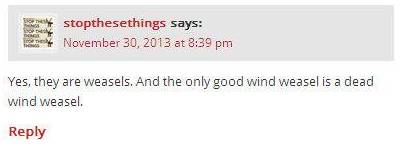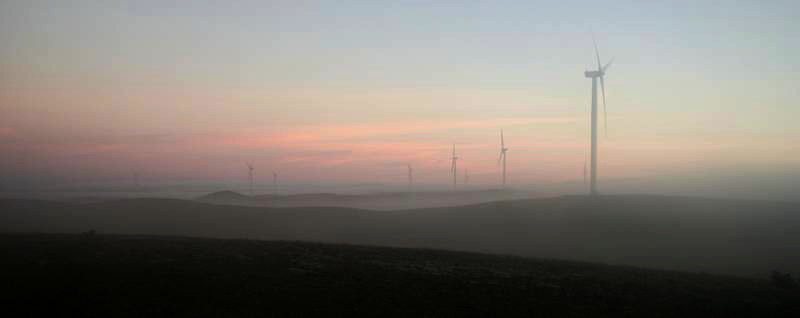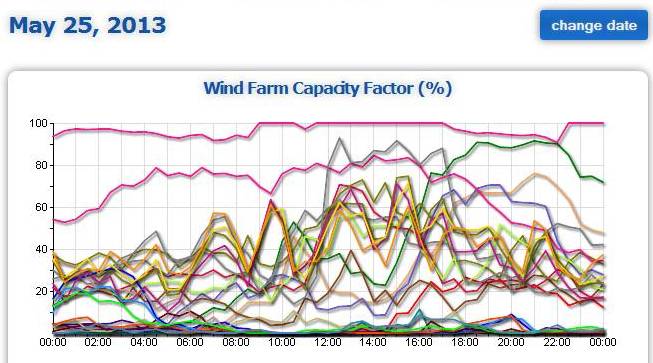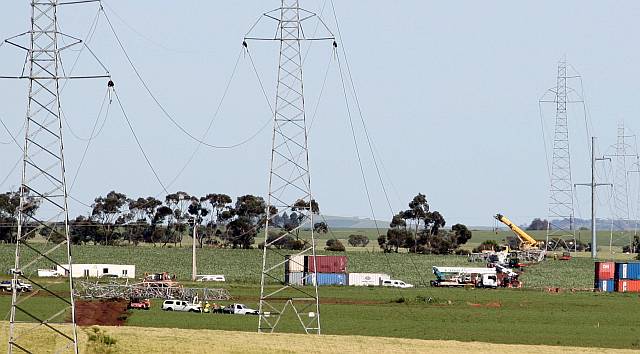As discussed on
another page on this site wind farm opponents are typically dishonest.
The subject of turbines and fires is no exception, with a number of fires being wrongly blamed on wind turbines and the severity of one very minor fire being greatly exaggerated.
Of particular relevance to this section there has been a claim on the Stop These Things site that "In Australia, wind turbines have so far been responsible for at least four serious bushfires:
- Ten Mile Lagoon in Western Australia in the mid-1990s;
- Lake Bonney, Millicent (SA) in January 2006;
- Cathedral Rocks Wind Farm, Port Lincoln (SA) in February 2009; and
- Starfish Hill (SA) in November 2010."
While at the time of writing this section I have not been able to find anything about the Ten Mile Lagoon fire (if there was one),
as I have shown below, the claims about all the other fires are false.
As discussed
on another page on this site a very dubious report made unsupported claims about a bushfire sparked by a turbine fire at the Lake Bonney Wind Farm.
This seems to have been picked up and repeated by wind farm opponents.
There is a short article about the fire, that occurred on 2006/01/22, on the
ABC News site with no mention of any fire beyond the immediate vicinity.
There was also an article written by David Nankervis and published in the South Australian Sunday Mail on 2006/02/12.
Nankervis's article was highly critical of wind power (as is common in the Murdoch-owned media) so there is no reason to believe that he would have minimised any damage caused by the fire.
Nankervis reported that the six fire appliances that attended the blaze couldn't do anything to extinguish the turbine fire because it was so high.
He went on the say:
"Instead, the firefighters watched as fire destroyed the $3 million turbine – which weighs 75 tonnes – and extinguished spot fired ignited by ashes from the turbine blaze"
Bird causes flash-over fire
Wind turbine opponents have blamed this fire on wind turbines, but it was caused by a bird and a power line.
The
Sydney Morning Herald reported on a fire on 17 January 2017 at
Currandooley, near Tarago in the Canberra area.
It seems that the power line involved carries power between Woodlawn and
Capital wind farms, both owned by Infigen.
The SMH article, by Georgina Connery, stated
"The fire started as a result of a bird flying close to high-voltage
powerlines, igniting and landing in dry grass."
The fire burned "almost 3400ha".
It seems that this was something of a freak event.
Birds being electrocuted by going too close to a couple of high voltage
power lines is apparently quite common, but to then set fire to grass is
very unusual.
Of course it could happen on any high voltage power line.
It seems that 2017/01/17 was a very hot day.
Louise Thrower in the Goulburn Post reported Infigen's response to the event:
"It was an unusual event.
We have had over 20 unplanned outages over four years prior to the recent
event and we suspect bird strikes on powerlines were responsible for all of
those.
(But) it has caused only one fire over four years".
Starfish Hill Wind Farm turbine fire
There was a fire in one of the
Starfish Hill Wind Farm turbines on the afternoon of 2010/10/30.
It was written up in an article in the Victor Harbor Times on 2010/11/04, but this seems no longer to be available.
The fire caused an estimated $3m damage.
This fire was reported on the anti-wind-power site Wind Watch.
Significantly there was no mention of the fire getting beyond the turbine except for a few spot fires nearby.
One of the
pages of Stop These Things carried the following
libellous statement:
"Simon Chapman is the professor of public health at the university [of
Sydney].
He has conducted a relentless campaign to vilify people who claim living near
turbines is affecting their health."
The author's name was given as 'stopthesethings' and the page was dated
January 5, 2013.
(I noticed it on 2013/01/06.)
Simon Chapman has not been vilifying people who claim illnesses from wind
turbines; rather he has been pointing out that wind turbines are not the
cause of any illnesses.
This false claim would legally constitute libel.
|
|
| Comment by STT
|
|---|

| |
Stop These Things showed how low they can go very well in a piece titled
More propaganda from Herr
Marsh of the Stasi.
It contained libellous statements, conspiracy theory, sarcasm and
name-calling, but nothing of any value.
The STT article from which the comment on the right was taken, titled
'Alan Jones and Sarah Laurie go on the attack', also contained the
following:
Sarah's been copping a wind industry funded attack from "Green" goons
like Senator "Die Nasty" in the last few weeks...
The writer of STT often uses similar insulting language and baseless claims.
Alan Jones is a climate change denying radio
'shock jock' and is one of the heros of STT.
Sarah Laurie has spread the unfounded belief that wind turbines make people sick.
On 2013/03/28 Stop These Things added a piece abusing Tim Flannery.
Typically STT wrote an
ad hominem attack on Tim, accusing him of 'cash for comment' and even
of being 'a fool'.
No matter how much one might dislike Tim Flannery (I am one of his many
admirers), to call him a fool is obviously ridiculous, the books he has
written are anything but the works of a fool.
As usual STT produced no valid
evidence justifying his attack on Tim Flannery's remarks.
Most of what STT wrote on the page was a personal attack on Mr Flannery.
But he had the gall to also say that "Simon Holmes a Court has a reputation
for personally attacking anybody critical of his two-turbine money machine"
(the community owned wind farm at Hepburn, Victoria).
When it comes to personal attacks STT, you are the greatest!
This was the headline of an imaginative posting in Stop These Things.
In their 'About' page Stop These Things say "We are appalled by the
dishonesty of the wind industry, its supporters and those who operate
within it."
This sort of statement is often made by wind power opponents, but they rarely
provide any evidence of said lying.
On 2013/03/29 STT published a piece titled "The wind industry's lies
dissected", by (the typically anonymous) 'special correspondent'.
And what were the big wind industry lies that were exposed?
Well, actually there was only one alleged lie involved and that was the
imaginary claim that wind energy can provide base load power.
Mr STT, when has a representative of the wind industry ever claimed that
wind can provide base load power?
Mr STT, who is lying here?
| |
|
This section added 2015/02/24
|
|
Stop These Things
has a page that claims to provide links to peer-reviewed science papers
showing convincing evidence that wind turbines harm people's health.
If the reader looks up the STT page he or she will note that many (or most)
of the so-called peer-reviewed articles were published in a journal called
the Bulletin of Science Technology and Society (BSTS).
How credible is this journal?
In the science publishing world this is measured by Impact Factor.
What is the Impact Factor of BSTS? Zero.
(See ResearchGate.)
More on the credibility of BSTS can be read
here.
Other of the references on the STT page related to annoyance more than health.
I don't think anyone is claiming that wind turbines don't annoy anybody.
People who start with negative perceptions of wind turbines are usually the
ones who are annoyed by them, those who have positive outlooks on wind power
(me for one) find the sound quite pleasant.
Of course people who start off with very negative views are even alloyed by
the site of wind turbines.
Yet other references on the STT page merely discussed the sound produced by
wind turbines.
|
|
| The failed anti-wind rally
|
|---|

| |
The anonymous writer of Stop These Things got together with climate science
denying shock jock Alan Jones and
Angus Taylor to hold an anti-wind power rally in Canberra on 2013/06/18.
With much less time to prepare, a group of pro-renewable people organised
a much more successful pro-wind, pro-renewables rally for the same time and
the other side of Lake Burley-Griffin.
The Jones-STT rally 'crowd' is shown in the photo at the right.
As can be seen, a large proportion of those who attended were from the
media.
A part of the crowd at the pro-renewables rally, estimated at from 500 to
1000, is in the photo below.
On the day, there were far more people at the pro-renewable
rally than at the anti-wind rally.
Photos credit Renew Economy, also see
Weekly Times Now.









